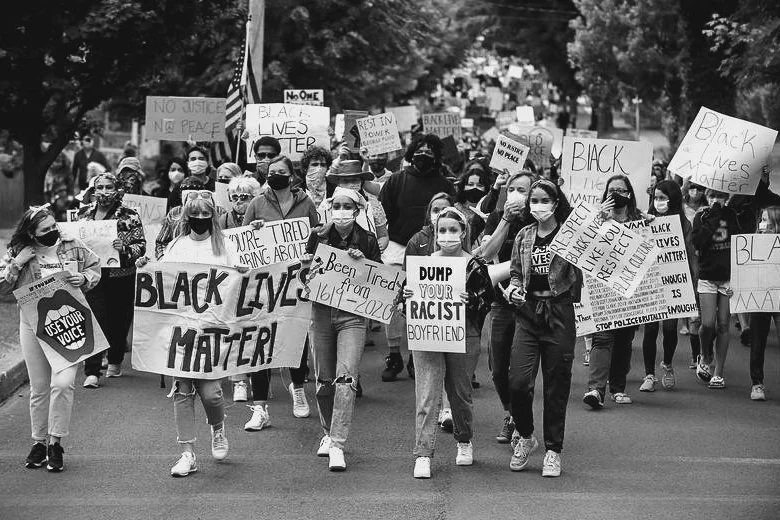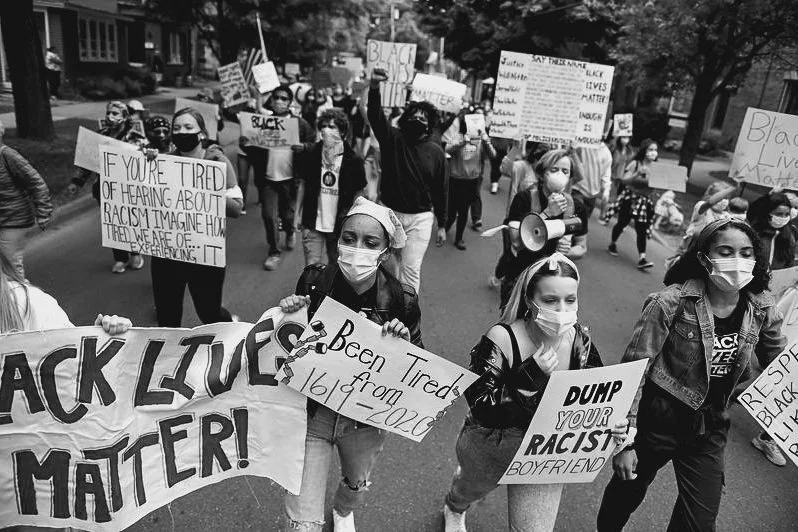Who Are the Black Squares Really For?
Written by: Zenia Nasevich
Image courtesy of Zoe Osborne / syracuse.com
In a fast-paced, media-driven world, the urge to post about a social issue as a knee-jerk reaction can be hard to shake. But where do we draw the line between virtue-signaling and genuine activism?
Over the last two years, your Instagram feed has probably been flooded with black squares, clickbait infographics, and GoFundMe links following George Floyd’s murder back in May 2020. The benefits seemed clear at the time: educate the public, examine our biases, and make complex social justice issues more palatable. We’ve all fallen victim to it. Those infographics would achieve just that and inspire meaningful change in a perfect world. But a lot of times, quick, shareable Instagram slides are inadequate, performative, or disingenuous.
To some, digital activism can open the door to self-education, but for others, the way it has been co-opted and commodified by brands and influencers leaves much to be desired when it comes to concrete social change. Take, for instance, the staggering number of large corporations who claimed to stand in solidarity with the Black community, despite having a tumultuous history with diversity and inclusion. Glossier committed to donating millions to Black-owned beauty businesses—a performative gesture—only after former employees attested to inequitable working environments. While consumers love to see their favorite brands align with issues that they care about, what they don’t love to see is a vague, gimmicky Instagram carousel with the same list of resources that every other brand or influencer has already posted, devoid of any concrete action. It should raise a red flag that these issues weren’t worth posting until it was deemed a “good” marketing move.
Trevor Sebben, a 21-year-old LGBTQ+ activist from upstate New York, believes that everyone should be well-informed before making any social media posts. Being 6’2” with an eccentric sense of style, he has faced public harassment and discrimination based on his appearance and sexual orientation, which in turn has made him highly passionate about LGBTQ+ issues. “I tend to stay out of things that I’m not educated about because I don’t want to take a voice away from someone else, but I’ll repost things about LGBTQ+ issues because of my own personal experiences,” he says. “I just prefer to do my own research and find reputable sources in the community who are making posts about social justice issues, as opposed to a brand like Nike.”
Zoe Osborne, a founding member of Skaneateles for Social Justice, knows that what activism ultimately comes down to is the way that people lead the charge in their day-to-day interactions. Both hailing from small towns, she and Sebben believe that providing educational resources and stopping the spread of misinformation on social media is paramount to combatting racism in less diverse living environments. Skaneateles’s racial makeup is 99% white, so being one of the few biracial people in her town, Osborne recognized the need for young voices to rise up and promote social justice conversations and reform in her community. “It’s been extremely difficult facing discrimination from ignorant people my entire life and barely having anyone else who looked like me, so when the BLM movement took over the entire country, I knew it was time to finally speak up,” she says.
Zoe Osborne protesting with Skaneateles for Social Justice. Image courtesy of Zoe Osborne / syracuse.com.
On the other hand, Sebben was eager to step back and listen, especially when it came to his small-town community just outside of Albany. “I went to the marches and rallies in my town because I thought it was important. Systemic racism is an issue everywhere. but it’s also so different in so many places, like in Albany versus Philadelphia,” he says. “I felt like I needed to go to a space where local people and activists would be talking to and educating me so I could know how to help better.”
Reposting an infographic from a well-intentioned or popular creator isn’t always a performance, but what it can do is inadvertently shift the blame onto one’s own social media followers, as if to say, “I’ve already done the work, but maybe you haven’t.” Sharing posts had a different meaning back in the summer of 2020. Social media was flooded with support and resources that seemed, in most cases, to be genuine, especially at the height of the pandemic.
But each time a new social issue comes to light, we see the same sentiments recycled as if it were just one-size-fits-all activism.
Reposting often removes all nuance from the multitude of social justice issues present in our society. In these cases, Osborne believes that “it’s best to take the opportunity to listen thoughtfully rather than speak ignorantly.” These issues are complex for a reason, and ten slides of an Instagram post can never wholly dissect centuries of history and sociology.
This isn’t all to say that activism has no place on social media. During the height of the Black Lives Matter protests, social media channels played an invaluable role in uncovering widespread police corruption in real time, raising funds for anti-racism organizations, and signal-boosting petitions for people who would otherwise have no platform. “When we organized a BLM march in Skaneateles, we never expected the turnout to be over 7,000 people. It goes to show how invaluable social media has been to mobilize people,” Osborne says.
Social media users have a responsibility to be more critical of performative activism and discern between genuine and virtue-signaling. Unfortunately, most closed-minded people won’t change their ways over a few disingenuous infographics. The real-world needs reliable allies and the conversation is far more likely to be genuine when it’s started offline. So before you participate in digital activism again, ask yourself who it’s really for.


